Six-Degree-of-Freedom Posture Measurement Technologies Using Position Sensitive Detectors (PSDs): State of the Art
Abstract
1. Introduction
- Difficult to achieve ultra-high precision, better than ± 1 μm and ± 1;
- Difficult to achieve measurement speed above 5 kHz;
- Hard to measure the 6-DOF posture simultaneously with simple configuration;
- Hard to measure the roll angle precisely;
- Lack of miniature systems capable of working in tiny spaces.
| Technology | Principle | Accuracy | Speed | Advantages | Limitations |
|---|---|---|---|---|---|
| Laser Tracking [19]  |
| 15 μm + 6 μm/m | 3000 Hz |
|
|
| Indoor GPS [20,21]  |
| 0.12 mm @ 10 m | 20 Hz |
|
|
| Digital Photography [22]  |
| 4 μm + 4 μm/m | 10 Hz |
|
|
Inertial measurement unit [23] |
| 10 mm/s | 3600 Hz |
|
|
2. PSD: A Promising Posture Detector
2.1. Performance Indicators of 6-DOF Measurement
- Resolution. Resolution refers to the minimum detectable changes in translation and rotation, which is directly dependent on the resolution of the used detector.
- Accuracy. Accuracy refers to the deviation of the measured value from the ground truth, which is generally expressed as RMS error.
- Repeatability. Repeatability refers to the variation of measurement results when continuously measure a constant posture over a period. It indicates the severity of random error in the system.
- Dynamic range. Dynamic range refers to the translation and rotation range that the system can properly detect. It should be greater than the motion scope of the target to be measured.
- Measurement speed. Measurement speed refers to the frequency of updating the measurement results. High measurement speed guarantees the real-time performance of the system.
2.2. Working Mechanism of PSD
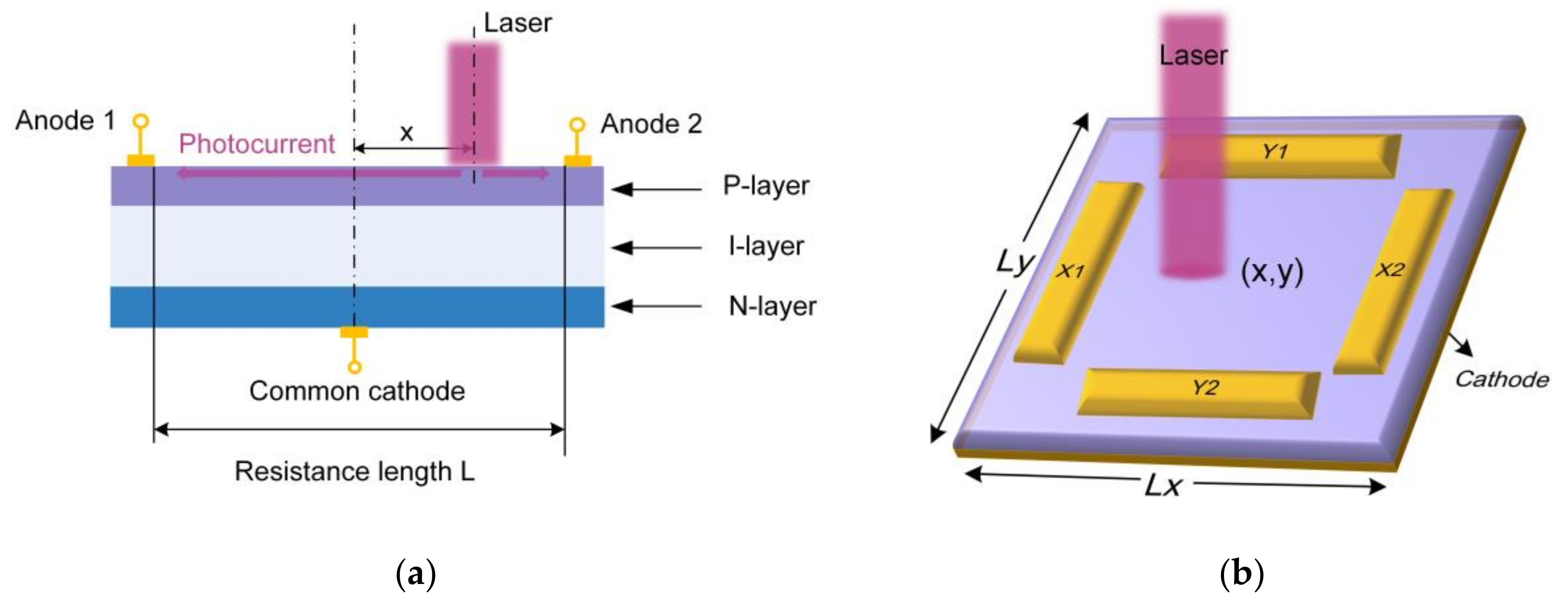
2.3. How Does PSD Solve the Challenges
- (1)
- PSD significantly improves the measurement accuracy.
- (2)
- PSD significantly improves the measurement resolution.
- (3)
- PSD enables ultra-fast measurement.
- (4)
- PSD greatly simplifies the system configuration.
3. 6-DOF Posture Measurement Systems Using PSDs
3.1. Large-Scale 6-DOF Posture Measurement in Equipment Assembly
3.1.1. Laser Tracking Technology
- (1)
- The measurement results are relevant to spot radius. QD estimates the spot position based on the distribution of the light intensity in each quadrant, and the relationship between the QD reading and the actual spot displacement is expressed as:where is the radius of light spot, represents the QD reading, and is the actual spot displacement. The content in brackets indicates that Equation (3) is valid on the condition that the coordinates of the spot should be much smaller than its diameter. From Equation (3), it is obvious that the QD reading is non-linear with the change of spot radius.
- (2)
- The measurement results are relevant to spot modes. QD shows the highest response for Airy spots but the lowest for uniform spots.
- (3)
- The measurement range is limited. Since the light spot must cover all quadrants of QD during the detection, which directly limits the measurement range and leads a narrow field-of-view (FOV).
3.1.2. Digital Photography Technology
3.2. Ultra-Precision 6-DOF Motion Error Measurement of Linear Stage
3.2.1. Laser Diffraction Method
3.2.2. Laser Collimation Method
3.3. Customized 6-DOF Posture Measurement in Other Emerging Areas
3.3.1. Kinematic Analysis Method
3.3.2. Angle of Arrival Method

4. Discussion
4.1. Comparative Analysis of Research Works
4.2. Challenges and Future Directions
- Based on the analysis results of the literature mentioned above, PSD-based 6-DOF posture measurement systems still need further exploration and improvement, which are mainly manifested in the following three aspects: Non-linear response: PSD has a certain degree of non-linearity, which is caused by non-desirable factors such as inhomogeneous resistive layers, non-zero load resistance and imperfect device isolation. The non-linearity is greater at the edges of photosensitive surface, which will reduce the accuracy of kinematic analysis method and binocular vision method since these two methods both use the edge area of PSDs.
- Dark current increases with PSD area: There is still a lack of large-area PSDs with low dark currents, posing the challenge that large dynamic range and high accuracy are difficult to obtain simultaneously for all methods.
- No internal gain: When detecting the weak light or working in long distance, the SNR will be not high enough to ensure high accuracy because PSD has no internal gains. Therefore, the working distances of laser diffraction method and laser collimation method are often sacrificed to obtain ultra-high resolution and extreme accuracy.
5. Conclusions
Author Contributions
Funding
Institutional Review Board Statement
Informed Consent Statement
Data Availability Statement
Conflicts of Interest
References
- Liu, C.S.; Pu, Y.F.; Chen, Y.T.; Luo, Y.T. Design of a Measurement System for Simultaneously Measuring Six-Degree-Of-Freedom Geometric Errors of a Long Linear Stage. Sensors 2018, 18, 3875. [Google Scholar] [CrossRef] [PubMed]
- Fan, K.C.; Chen, M.J. A 6-degree-of-freedom measurement system for the accuracy of X-Y stages. Precis. Eng. 2000, 24, 15–23. [Google Scholar] [CrossRef]
- Tobergte, A.; Pomarlan, M.; Hirzinger, G. Robust Multi Sensor Pose Estimation for Medical Applications. In Proceedings of the 2009 IEEE/RSJ International Conference on Intelligent Robots and Systems, St. Louis, MO, USA, 10–15 October 2009; pp. 492–497. [Google Scholar]
- Foxlin, E.M. Head Tracking Relative to a Moving Vehicle or Simulator Platform Using Differential Inertial Sensors. In Proceedings of the AeroSense 2000, Orlando, FL, USA, 24–28 April 2000; pp. 133–144. [Google Scholar]
- Liu, S.; Sun, Y.; Peng, G.; Xue, Y.; Hnydiuk-Stefan, A.; Li, Z. Development of a Novel 6-DOF Hybrid Serial-Parallel Mechanism for Pose Adjustment of Large-Volume Components. Proc. Inst. Mech. Eng. Part C J. Mech. Eng. Sci. 2021, 236, 2099–2114. [Google Scholar] [CrossRef]
- Peng, G.; Sun, Y.; Xu, S. Development of an Integrated Laser Sensors Based Measurement System for Large-Scale Components Automated Assembly Application. IEEE Access 2018, 6, 45646–45654. [Google Scholar] [CrossRef]
- Sheng, Y.; Sun, J.; Wang, W.; Stuart, B.; Kong, L.; Gao, J.; You, D.; Wu, X. Performance of a 6D Treatment Chair for Patient Positioning in an Upright Posture for Fixed Ion Beam Lines. Front. Oncol. 2020, 10, 122. [Google Scholar] [CrossRef]
- Hu, L.; Duan, H.; Pei, H. Binocoular vision position and attitude measurement for key features of non-cooperative spacecraft. Chin. J. Lasers 2022, 49. [Google Scholar]
- Zhou, D.; Gao, D.; Dong, D. Automatic attitude measurement of laser tracker based on deep learning and pNP model. Opt. Precis. Eng. 2022, 30, 1047–1057. [Google Scholar] [CrossRef]
- Gao, Y.; Liu, W. Six-degree-of-freedom displacement and angle measurement system based on two-dimensional position-sensitive detector. Opt. Precis. Eng. 2018, 26, 2930–2939. [Google Scholar] [CrossRef]
- Liu, B.; Li, Y.; Meng, H. Large diameter telescope primary mirror position detection and control. Transducer Microsyst. Technol. 2016, 35, 132–134. [Google Scholar]
- Cui, C.; Feng, Q.; Zhang, B.; Zhao, Y. System for simultaneously measuring 6-DOF geometric motion errors using a polarization maintaining fiber-coupled dual-frequency laser. Opt. Express 2016, 24, 6735–6748. [Google Scholar] [CrossRef]
- Liu, K.; Wang, W.; Yu, Y.; Hou, X.; Liu, Y.; Chen, W.; Wang, X.; Lu, J.; Ni, Z. Graphene-based infrared position-sensitive detector for precise measurements and high-speed trajectory tracking. Nano Lett. 2019, 19, 8132–8137. [Google Scholar] [CrossRef]
- Chen, Y.; Yang, X.; Zhang, C.; He, G.; Chen, X.; Qiao, Q.; Zang, J.; Dou, W.; Sun, P.; Deng, Y. Ga2O3-Based Solar-Blind Position-Sensitive Detector for Noncontact Measurement and Optoelectronic Demodulation. Nano Lett. 2022, 22, 4888–4896. [Google Scholar] [CrossRef]
- Kim, J.-K.; Kim, M.-S.; Bae, J.H.; Kwon, J.H.; Lee, H.-B.; Jeong, S.-H. Gap measurement by position-sensitive detectors. Appl. Opt. 2000, 39, 2584–2591. [Google Scholar] [CrossRef]
- Pan, T.; Fan, B.; Yi, W. Overview of large-scale dynamic measurment metrology. Geomat. Spat. Inf. Technol. 2015, 38, 70–76. [Google Scholar]
- Du, F.; Wen, K. Large-scale precision measurement technology and its application. Aeronaut. Manuf. Technol. 2016, 2016, 16–24. [Google Scholar]
- Li, G.; Fan, B. The development of precise engineering surveying technology. Acta Geod. Cartogr. Sin. 2017, 46, 1742–1751. [Google Scholar]
- Muralikrishnan, B.; Phillips, S.; Sawyer, D. Laser trackers for large-scale dimensional metrology: A review. Precis. Eng. 2016, 44, 13–28. [Google Scholar] [CrossRef]
- Norman, A.R.; Schönberg, A.; Gorlach, I.A.; Schmitt, R. Validation of iGPS as an external measurement system for cooperative robot positioning. Int. J. Adv. Manuf. Technol. 2013, 64, 427–446. [Google Scholar] [CrossRef]
- Schmitt, R.; Nisch, S.; Schönberg, A.; Demeester, F.; Renders, S. Performance Evaluation of iGPS for Industrial Applications. In Proceeding of 2010 International Conference on Indoor Positioning and Indoor Navigation, Zurich, Switzerland, 15–17 September 2010; pp. 1–8. [Google Scholar]
- Zheng, J.; Li, W. Calibration of 3-D measurement system based on a double position sensitive detectors. J. Tsinghua Univ. Sci. Technol. 2018, 58, 411–416. [Google Scholar]
- Rahni, A.A.A.; Yahya, I. Obtaining Translation from a 6-DOF MEMS IMU—An Overview. In Proceedings of the 2007 Asia-Pacific Conference on Applied Electromagnetics, Melaka, Malaysia, 4–6 December 2007; pp. 1–5. [Google Scholar]
- Hsieh, H.L.; Pan, S.W. Development of a grating-based interferometer for six-degree-of-freedom displacement and angle measurements. Opt. Express 2015, 23, 2451–2465. [Google Scholar] [CrossRef]
- Lin, S.-T.; Yeh, S.-L.; Chiu, C.-S.; Huang, M.-S. A calibrator based on the use of low-coherent light source straightness interferometer and compensation method. Opt. Express 2011, 19, 21929–21937. [Google Scholar] [CrossRef] [PubMed]
- Chen, B.; Xu, B.; Yan, L.; Zhang, E.; Liu, Y. Laser straightness interferometer system with rotational error compensation and simultaneous measurement of six degrees of freedom error parameters. Opt. Express 2015, 23, 9052–9073. [Google Scholar] [CrossRef] [PubMed]
- Lou, Y.; Yan, L.; Chen, B.; Zhang, S. Laser homodyne straightness interferometer with simultaneous measurement of six degrees of freedom motion errors for precision linear stage metrology. Opt. Express 2017, 25, 6805–6821. [Google Scholar] [CrossRef] [PubMed]
- Wallmark, J.T. A new semiconductor photocell using lateral photoeffect. Proc. IRE 1957, 45, 474–483. [Google Scholar] [CrossRef]
- Yamamoto, K.; Yamaguchi, S.; Terada, Y. New structure of two-dimensional position sensitive semiconductor detector and application. IEEE Trans. Nucl. Sci. 1985, 32, 438–442. [Google Scholar] [CrossRef]
- Qian, D.; Wang, W.; Busch-Vishniac, I.J. A method for measurement of multiple light spot positions on one position-sensitive detector (PSD). IEEE Trans. Instrum. Meas. 1993, 42, 14–18. [Google Scholar] [CrossRef]
- Andersson, H. Position Sensitive Detectors: Device Technology and Applications in Spectroscopy. Ph.D. Thesis, Mid Sweden University, Institution of Information Technology and Media, Sundsvall, Sweden, 2008. [Google Scholar]
- Hu, C.; Wang, X.; Song, B. High-performance position-sensitive detector based on the lateral photoelectrical effect of two-dimensional materials. Light Sci. Appl. 2020, 9, 88. [Google Scholar] [CrossRef]
- Sun, S.; Zheng, Q.; Meng, X.; Sun, P.; Liu, F.; Cao, L. High Positional Resolution Pin-Cushion Position Sensitive Detector by Deliberately Introducing Barrel Distortion. IEEE Sens. J. 2021, 22, 1280–1286. [Google Scholar] [CrossRef]
- Wang, W.; Busch-Vishniac, I.J. The linearity and sensitivity of lateral effect position sensitive devices-an improved geometry. IEEE Trans. Electron Devices 1989, 36, 2475–2480. [Google Scholar] [CrossRef]
- Lucovsky, G. Photoeffects in nonuniformly irradiated p-n junctions. J. Appl. Phys. 1960, 31, 1088–1095. [Google Scholar] [CrossRef]
- Noorlag, D. Quantitative analysis of effects causing nonlinear position response in position-sensitive photodetectors. IEEE Trans. Electron Devices 1982, 29, 158–161. [Google Scholar] [CrossRef]
- Zhou, C.; Wang, W.; Chao, H.; Hong, L.; Cao, X.; Zhang, P.; Chu, L. The study on the method of eliminating errors of psd. Sens. Transducers 2013, 25, 52. [Google Scholar]
- Wang, W.; Lu, J.; Ni, Z. Position-sensitive detectors based on two-dimensional materials. Nano Res. 2020, 14, 1889–1900. [Google Scholar] [CrossRef]
- Henry, J.; Livingstone, J. Thin-Film Amorphous Silicon Position-Sensitive Detectors. Adv. Mater. 2001, 13, 1022–1026. [Google Scholar] [CrossRef]
- Onishi, K.; Tanaka, D.; Misaki, Y.; Yang, S. 3D Position Detection with a PSD Using Frequency Modulated Light Markers. In Proceedings of the 3rd International Conference on Industrial Application Engineering, Kitakyushu, Japan, 28–31 March 2015; pp. 227–233. [Google Scholar]
- Zhou, P.; Lu, R.; Zhou, W. Measurement system for laser tracker’s target-missing quantity based on four-quardant detector. Electro-optic Technol. Appl. 2014, 29, 75–79. [Google Scholar]
- Zhang, H.; Chen, Y.; Geng, T. Study on main factors affecting position detection accuracy of four-quardant detector. Chin. J. Lasers 2015, 42, 306–314. [Google Scholar]
- Zhang, L.; Zhang, G.; Liu, Y. Affecting factor for detection accuracy of four-quardant detector. Chin. J. Lasers 2012, 39, 121–125. [Google Scholar]
- Dong, D.; Zhou, W.; Ji, R. Design of precise tracking system of laser tracker. Opt. Precis. Eng. 2016, 24, 310–318. [Google Scholar]
- Dong, D.; Chen, Z.; Zhou, W. Precise detecting method of target miss-distance for laser tracker. Infrared Laser Eng. 2016, 45, 150–156. [Google Scholar]
- Wu, L.; Su, Y.; Chen, Z.; Chen, S.; Cheng, S.; Lin, P. Six-degree-of-freedom generalized displacements measurement based on binocular vision. Struct. Control Health Monit. 2020, 27, e2458. [Google Scholar] [CrossRef]
- Yu, K.; Dai, W.; Cong, M. Binocular vision 6-DOF pose measurement method based on docking ring. In Proceedings of the Applied Optics and Photonics China (AOPC2019), Beijing, China, 7–9 July 2019; pp. 125–132. [Google Scholar]
- Lin, C.-Y.; Chiu, Y.-P.; Lin, C.-Y.; Tsai, C.-R. Development of a binocular vision-based catcher robot system using DSP platform. J. Chin. Inst. Eng. 2014, 37, 210–223. [Google Scholar] [CrossRef]
- Liu, J.; Zhang, P.; Cheng, S. Research on spatial spot position measurement based on dual PSD vision. J. Electron. Meas. Instrum. 2022, 36, 81–88. [Google Scholar]
- Basheer, I.; Hajmeer, M. Artificial neural networks: Fundamentals, computing, design, and application. J. Microbiol. Methods 2000, 43, 3–31. [Google Scholar] [CrossRef]
- Lin, C.; Zheng, S.; Li, P.; Shen, Z.; Wang, S. Positioning Error Analysis and Control of a Piezo-Driven 6-DOF Micro-Positioner. Micromachines 2019, 10, 542. [Google Scholar] [CrossRef] [PubMed]
- Poulton, M.M. Multi-Layer Perceptrons and Back-Propagation Learning. In Handbook of Geophysical Exploration: Seismic Exploration; Elsevier: Amsterdam, The Netherlands, 2001; pp. 27–53. [Google Scholar]
- Lu, X.; Wang, Y.; Li, J. Prediction of three-dimensional coordinate measurement of space points based on BP neural network. Manuf. Res. 2020, 15, 218–233. [Google Scholar] [CrossRef]
- Cheng, S.; Liu, J.; Zhang, P. Cooperative target pose detection method based on PSD and light source modulation. J. Sichuan Univ. Nat. Sci. Ed. 2022, 59, 043002. [Google Scholar]
- Fortin, G. Graphical representation of the diffraction grating equation. Am. J. Phys. 2008, 76, 43–47. [Google Scholar] [CrossRef]
- Kim, J.-A.; Kim, K.-C.; Bae, E.W.; Kim, S.; Kwak, Y.K. Six-degree-of-freedom displacement measurement system using a diffraction grating. Rev. Sci. Instrum. 2000, 71, 3214–3219. [Google Scholar] [CrossRef]
- Kim, J.-A.; Bae, E.W.; Kim, S.H.; Kwak, Y.K. Design methods for six-degree-of-freedom displacement measurement systems using cooperative targets. Precis. Eng. 2002, 26, 99–104. [Google Scholar] [CrossRef]
- Lee, C.; Kim, G.H.; Lee, S.-K. Design and construction of a single unit multi-function optical encoder for a six-degree-of-freedom motion error measurement in an ultraprecision linear stage. Meas. Sci. Technol. 2011, 22, 105901. [Google Scholar] [CrossRef]
- Liu, W.; Zhang, C.; Duan, F.; Fu, X.; Bao, R.; Yan, M. A method for noise attenuation of straightness measurement based on laser collimation. Measurement 2021, 182, 109643. [Google Scholar] [CrossRef]
- Feng, Q.; Zhang, B.; Cui, C.; Kuang, C.; Zhai, Y.; You, F. Development of a simple system for simultaneously measuring 6-DOF geometric motion errors of a linear guide. Opt. Express 2013, 21, 25805–25819. [Google Scholar]
- Zhao, Y.; Zhang, B.; Feng, Q. Measurement system and model for simultaneously measuring 6-DOF geometric errors. Opt. Express 2017, 25, 20993–21007. [Google Scholar] [CrossRef]
- Ren, W.; Cui, J.; Tan, J. Parallel beam generation method for a high-precision roll angle measurement with a long working distance. Opt. Express 2020, 28, 34489–34500. [Google Scholar] [CrossRef]
- Jin, Y.; Chen, I.-M.; Yang, G. Kinematic design of a 6-DOF parallel manipulator with decoupled translation and rotation. IEEE Trans. Robotics 2006, 22, 545–551. [Google Scholar] [CrossRef]
- Wang, W.; Kweon, S.-H.; Hwang, C.-S.; Kang, N.-C.; Kim, Y.-S.; Yang, S.-H. Development of an optical measuring system for integrated geometric errors of a three-axis miniaturized machine tool. Int. J. Adv. Manuf. Technol. 2008, 43, 701–709. [Google Scholar] [CrossRef]
- Li, Z. 3D position measurement of active isolation system under space microgravity. J. Astronaut. 2010, 31, 1625–1630. [Google Scholar]
- Luo, J.; Fan, L.; Li, H. Indoor Positioning Systems Based on Visible Light Communication: State of the Art. IEEE Commun. Surv. Tutor. 2017, 19, 2871–2893. [Google Scholar] [CrossRef]
- De-La-Llana-Calvo, A.; Lazaro-Galilea, J.L.; Gardel-Vicente, A. Characterization of Multipath Effects in Indoor Positioning Systems by AoA and PoA Based on Optical Signals. Sensors 2019, 19, 917. [Google Scholar] [CrossRef]
- De-La-Llana-Calvo, A.; Lazaro-Galilea, J.L.; Gardel-Vicente, A. Analysis of Multiple-Access Discrimination Techniques for the Development of a PSD-Based VLP System. Sensors 2020, 20, 1717. [Google Scholar] [CrossRef]
- Rodriguez-Navarro, D.; Lazaro-Galilea, J.L.; De-La-Llana-Calvo, A. Indoor Positioning System Based on a PSD Detector, Precise Positioning of Agents in Motion Using AoA Techniques. Sensors 2017, 17, 2124. [Google Scholar] [CrossRef] [PubMed]
- Rodriguez-Navarro, D.; Lazaro-Galilea, J.L.; Bravo-Munoz, I. Mathematical Model and Calibration Procedure of a PSD Sensor Used in Local Positioning Systems. Sensors 2016, 16, 1484. [Google Scholar] [CrossRef] [PubMed]
- Rodriguez-Navarro, D.; Lazaro-Galilea, J.L.; Bravo-Munoz, I.; Gardel-Vicente, A. Analysis and Calibration of Sources of Electronic Error in PSD Sensor Response. Sensors 2016, 16, 619. [Google Scholar] [CrossRef]
- De-La-Llana-Calvo, A.; Salido-Monzu, D.; Lazaro-Galilea, J.L.; Gardel-Vicente, A.; Bravo-Munoz, I.; Rubiano-Muriel, B. Accuracy and Precision Assessment of AoA-Based Indoor Positioning Systems Using Infrastructure Lighting and a Position-Sensitive Detector. Sensors 2020, 20, 5359. [Google Scholar] [CrossRef]
- De-La-Llana-Calvo, A.; Lazaro-Galilea, J.L.; Alcazar-Fernandez, A. Accuracy and Precision of Agents Orientation in an Indoor Positioning System Using Multiple Infrastructure Lighting Spotlights and a PSD Sensor. Sensors 2022, 22, 2882. [Google Scholar] [CrossRef]
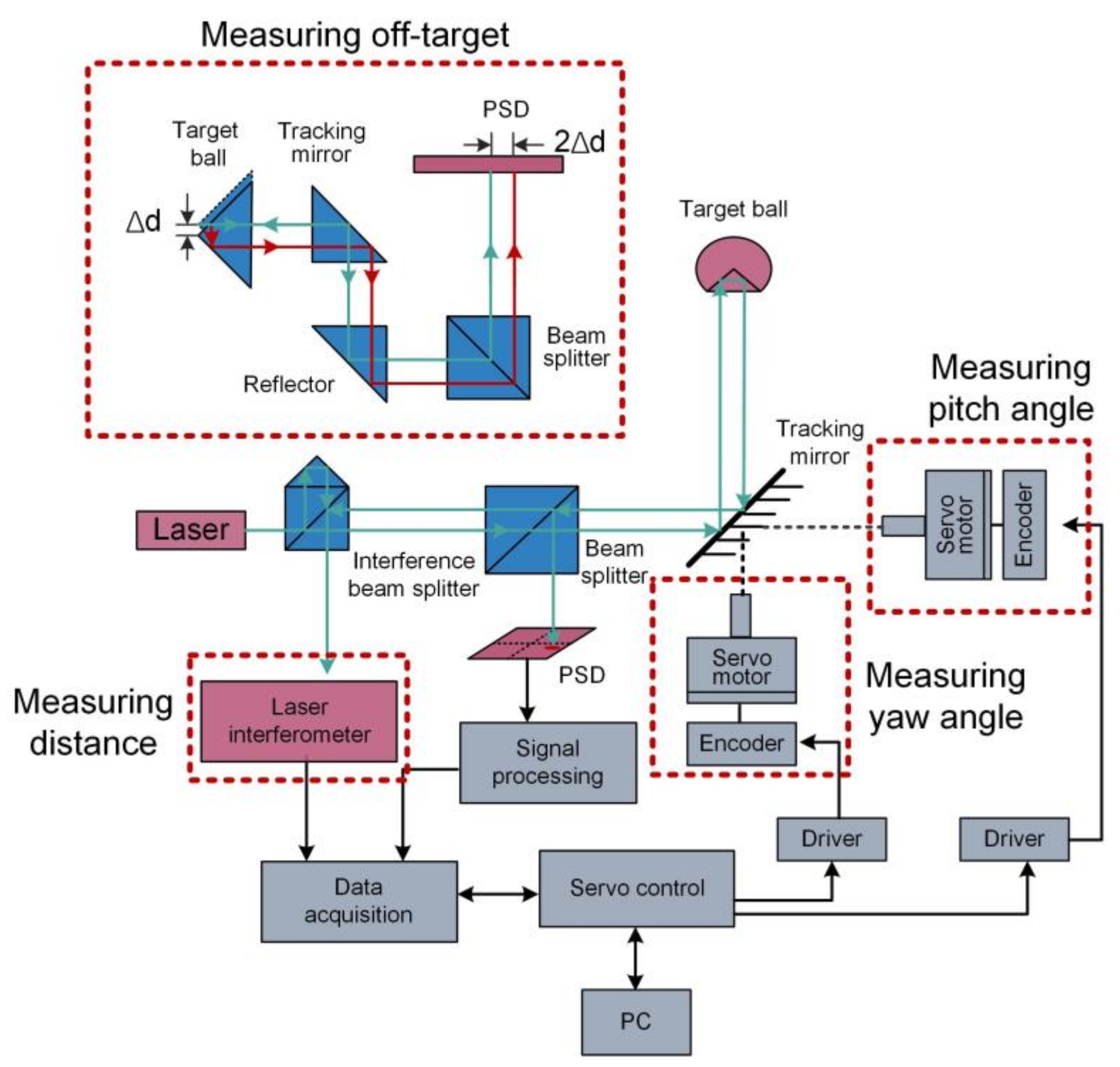
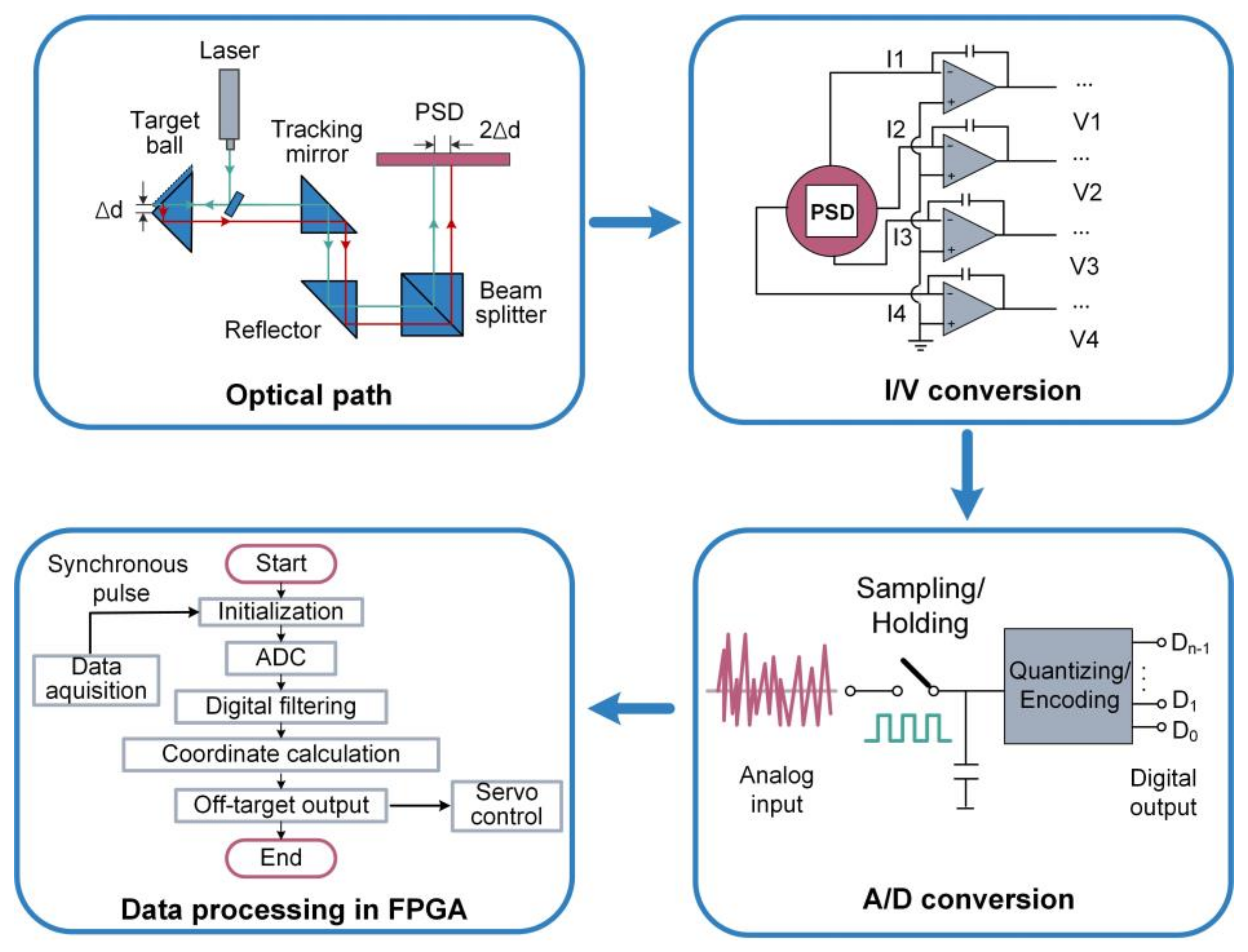
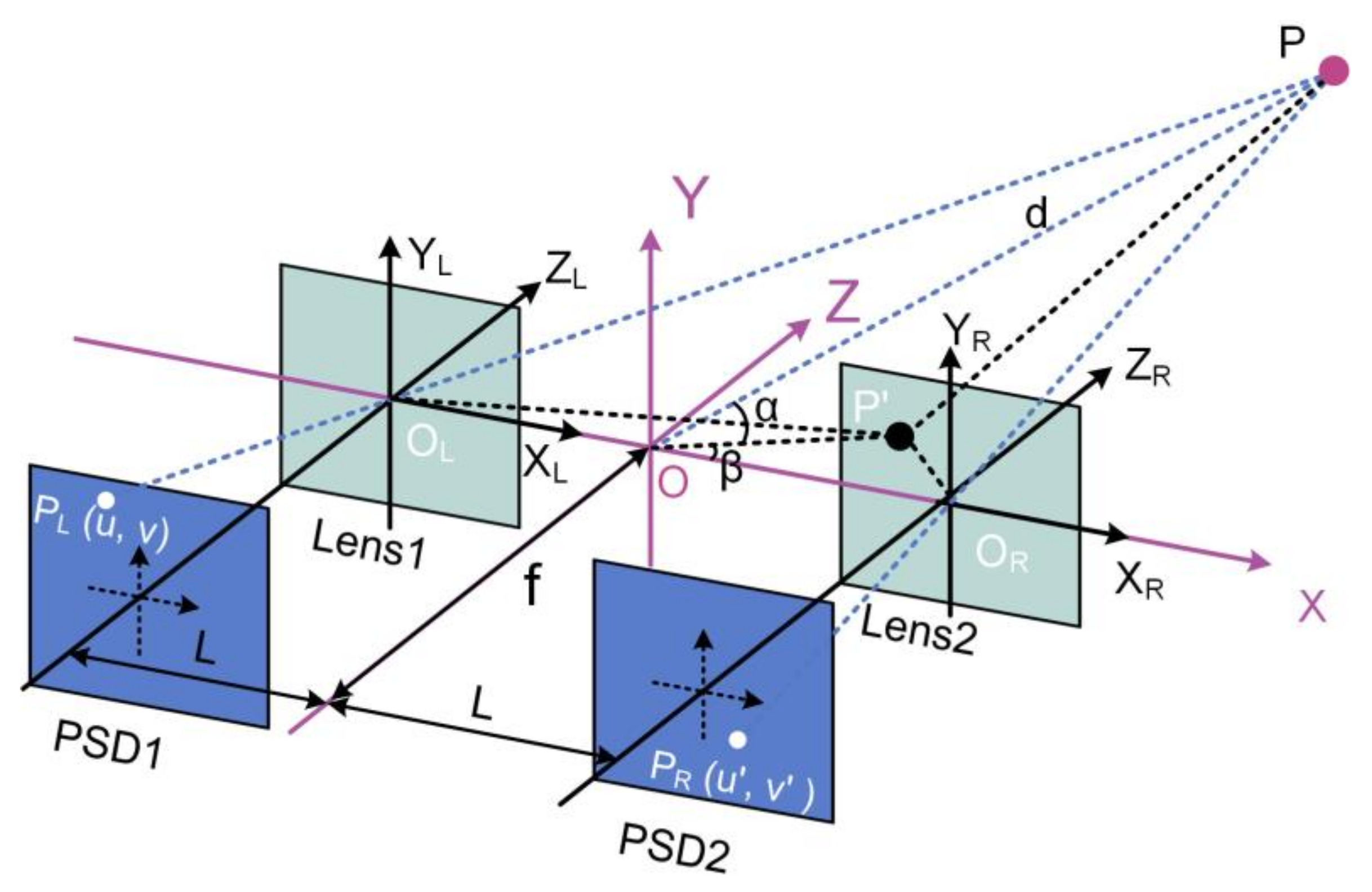
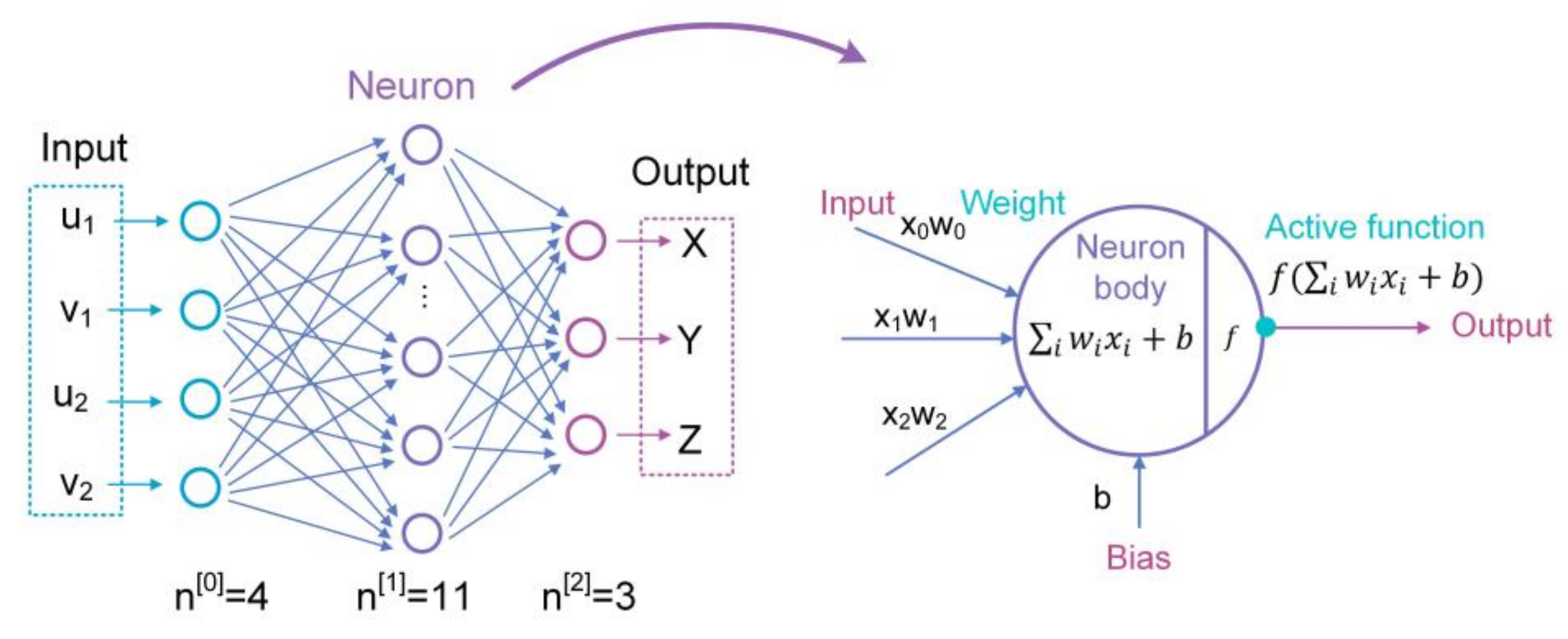
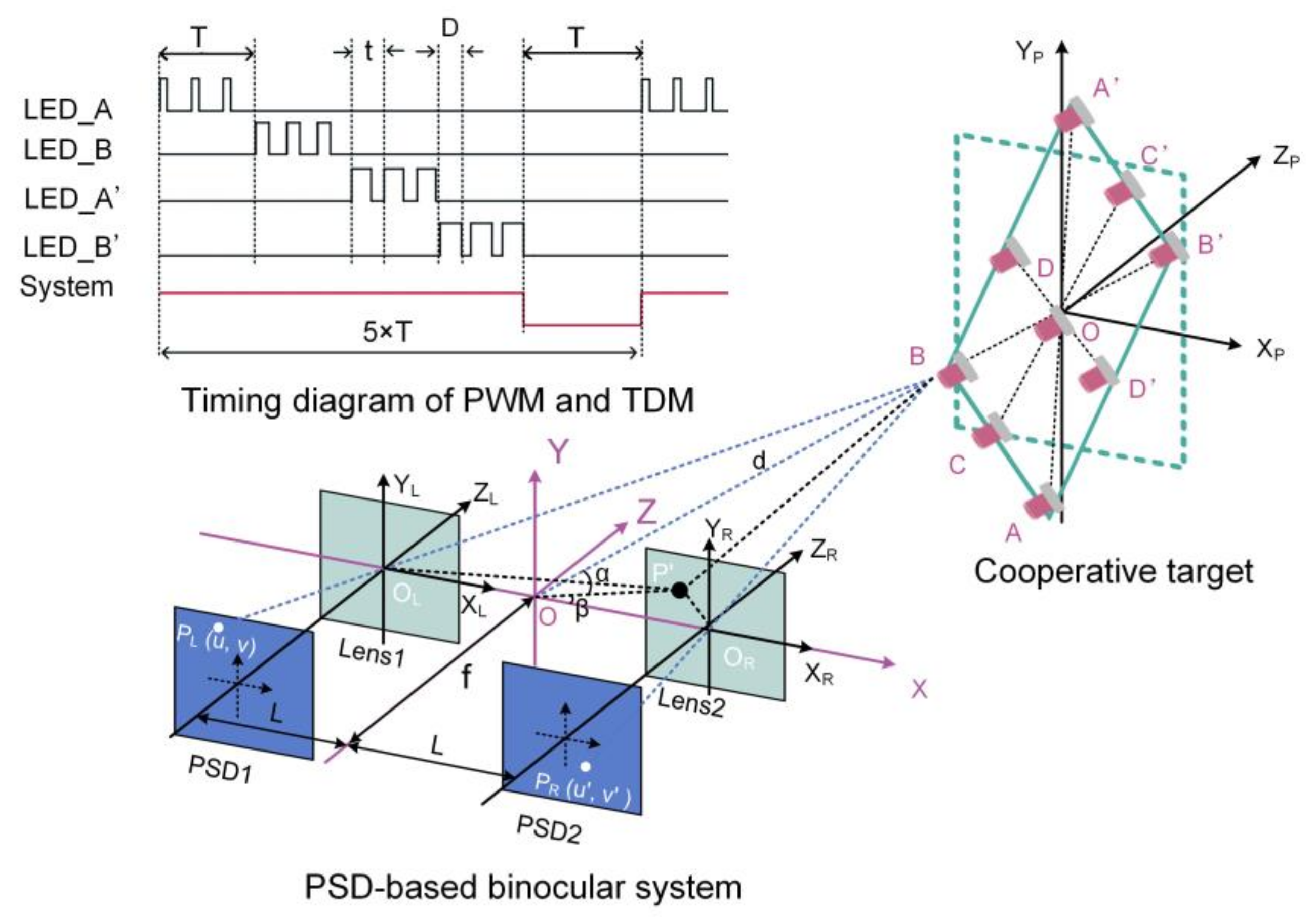

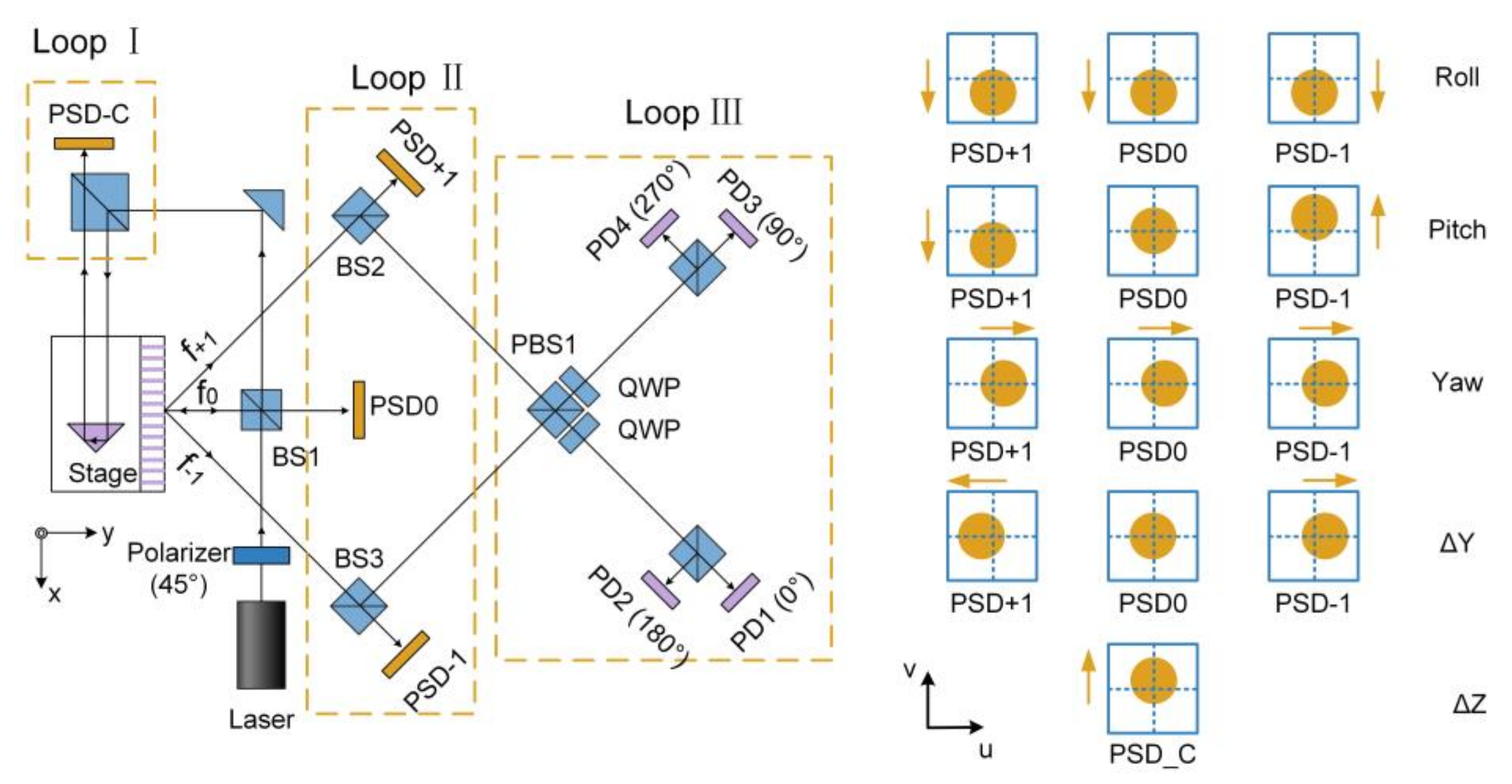


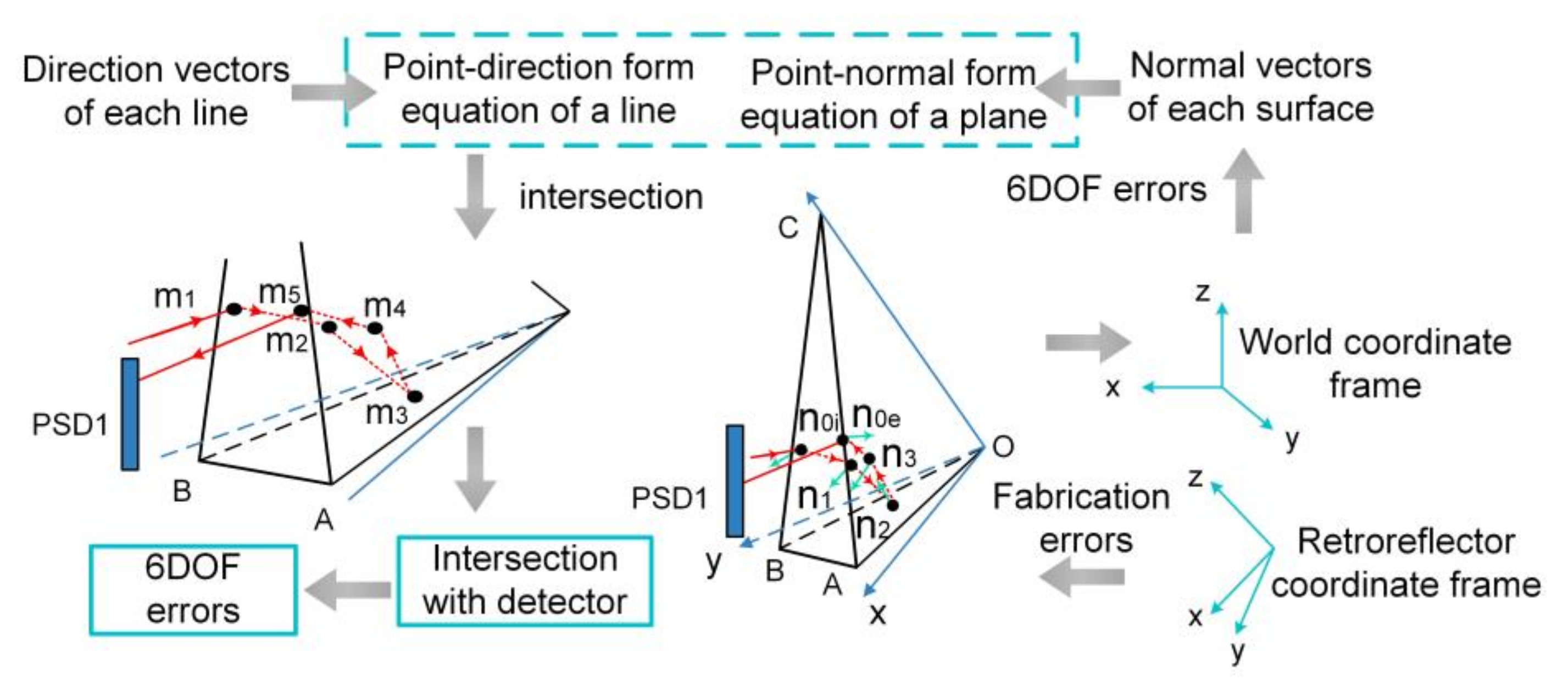

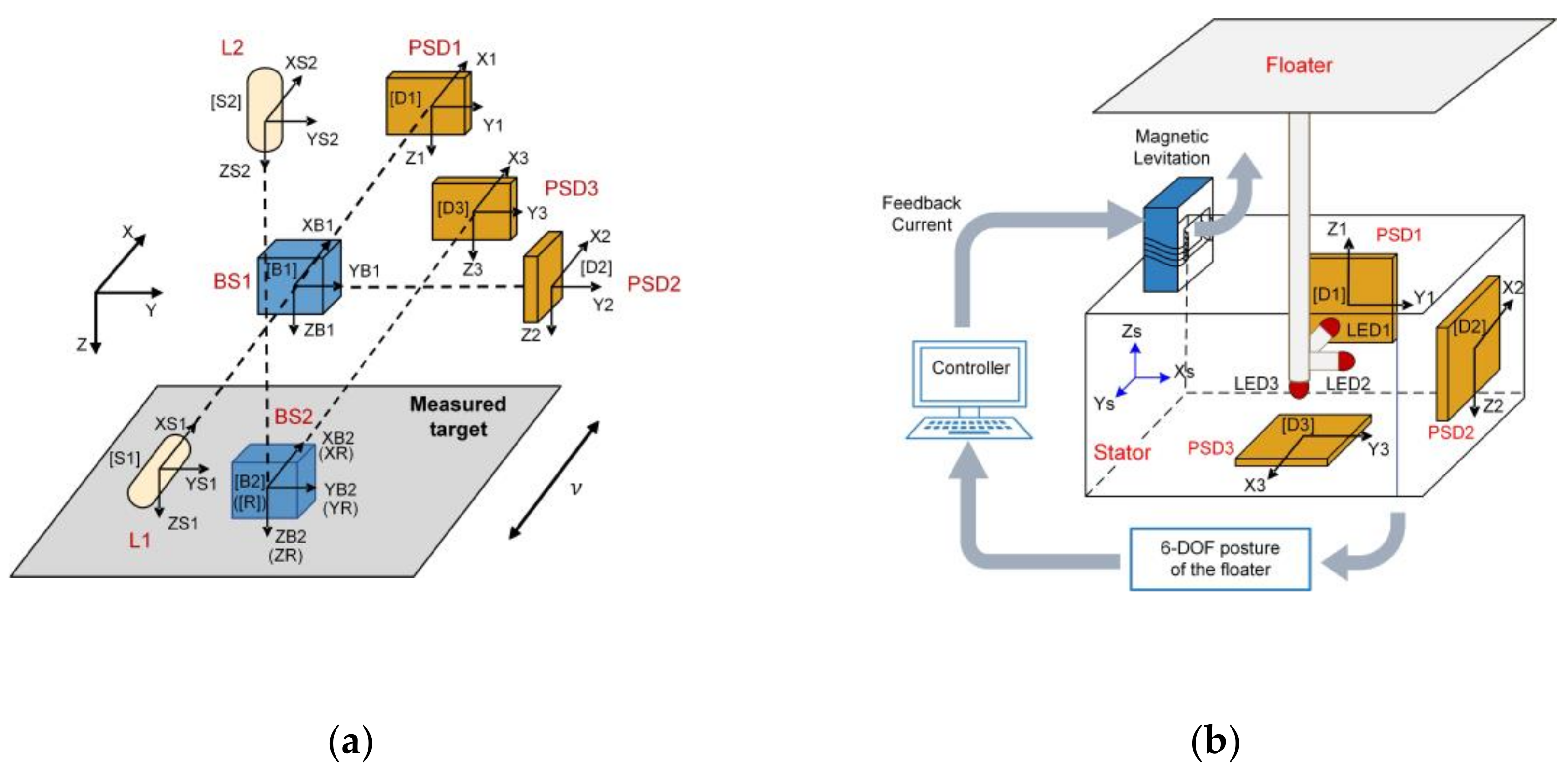
| Applications | Brief Description | Required Accuracy | Required Range |
|---|---|---|---|
| On-orbit Servicing [8] | Detecting the pose of the target spacecraft for capture, repair, and docking. | 5 mm 2° | ± 30 m ± 40° |
| On-site Assembly of Large-scale Components [9] | Detecting the posture of large components to guarantee assembly accuracy. | 1 mm 0.25° | 0~20 m 20° |
| Microgravity Active Vibration Isolation System [10] | Detecting the pose of lab bench to provide microgravity for scientific experiments. | 0.5 mm 0.5° | ± 10 mm ± 2.5° |
| Astronomical Observations [11] | Detecting the pose of secondary mirrors to improve the imaging quality of the telescope. | 10 μm 1″ | ± 2 mm ± 1500″ |
| Ultraprecision Manufacturing [12] | Detecting the motion errors of the linear stage to improve the manufacture accuracy. | 0.5 μm 0.5″ | ± 100 μm ± 100″ |
| Authors | Method | Resolution | Accuracy | Repeatability | Range | Speed | Compactness |
|---|---|---|---|---|---|---|---|
| Dong [44] (2016) | Laser tracking | ★★★★ | ★★★★ | ★★★★★ | ★★★★ | ★★★ | ★★★ |
| Liu [49] (2022) | Binocular vision | ★★ | ★★ | ★★★ | ★★★★★ | ★★★ | ★★★★★ |
| Wang [38] (2020) | Binocular vision | ★★★ | ★★★ | ★★ | ★★★★★ | ★★ | ★★★★★ |
| Cheng [54] (2022) | Binocular vision | ★★★ | ★★★ | ★★★ | ★★★ | ★★ | ★★★★★ |
| Kim [56] (2000) | Laser diffraction | ★★★ | ★★★★ | ★★★★ | ★★ | ★★★★ | ★★★ |
| Kim [57] (2002) | Laser diffraction | ★★★ | ★★★★★ | ★★★★ | ★★ | ★★★★ | ★★★ |
| Lee [58] (2011) | Laser diffraction | ★★★★★ | ★★★★ | ★★★★ | ★★ | ★★★★ | ★★ |
| Feng [60] (2013) | Laser collimation | ★★★★★ | ★★★★ | ★★★ | ★★ | ★★★★ | ★★★ |
| Zhao [61] (2017) | Laser collimation | ★★★★★ | ★★★★★ | ★★★ | ★★ | ★★★ | ★★★ |
| Ren [62] (2020) | Laser collimation | ★★★★★ | ★★★★★ | ★★★ | ★★★ | ★★★★ | ★★ |
| Wang [64] (2008) | Kinematic analysis | ★★★★★ | ★★★★ | ★★★ | ★★★ | ★★★★ | ★★★★ |
| Gao [10] (2019) | Kinematic analysis | ★★★ | ★★★ | ★★★ | ★★★★ | ★★★★ | ★★★★★ |
| David [69] (2017) | Angle-of-arrival | ★★ | ★★ | ★★ | ★★★★ | ★★★★ | ★★★★★ |
| Alvaro [72] (2020) | Angle-of-arrival | ★★ | ★★ | ★★ | ★★★★ | ★★★★ | ★★★★★ |
Publisher’s Note: MDPI stays neutral with regard to jurisdictional claims in published maps and institutional affiliations. |
© 2022 by the authors. Licensee MDPI, Basel, Switzerland. This article is an open access article distributed under the terms and conditions of the Creative Commons Attribution (CC BY) license (https://creativecommons.org/licenses/by/4.0/).
Share and Cite
Meng, X.; Sun, S.; Yan, X.; Liu, F.; Cao, L.; Wang, Q.; Sun, Y. Six-Degree-of-Freedom Posture Measurement Technologies Using Position Sensitive Detectors (PSDs): State of the Art. Micromachines 2022, 13, 1903. https://doi.org/10.3390/mi13111903
Meng X, Sun S, Yan X, Liu F, Cao L, Wang Q, Sun Y. Six-Degree-of-Freedom Posture Measurement Technologies Using Position Sensitive Detectors (PSDs): State of the Art. Micromachines. 2022; 13(11):1903. https://doi.org/10.3390/mi13111903
Chicago/Turabian StyleMeng, Xiangxu, Siwei Sun, Xuetao Yan, Fengman Liu, Liqiang Cao, Qidong Wang, and Yu Sun. 2022. "Six-Degree-of-Freedom Posture Measurement Technologies Using Position Sensitive Detectors (PSDs): State of the Art" Micromachines 13, no. 11: 1903. https://doi.org/10.3390/mi13111903
APA StyleMeng, X., Sun, S., Yan, X., Liu, F., Cao, L., Wang, Q., & Sun, Y. (2022). Six-Degree-of-Freedom Posture Measurement Technologies Using Position Sensitive Detectors (PSDs): State of the Art. Micromachines, 13(11), 1903. https://doi.org/10.3390/mi13111903






